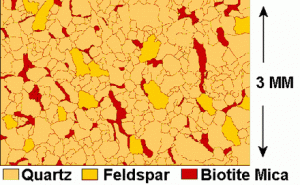Sandstones are mainly composed of grains of the hard mineral quartz. These quartz grains are usually angular when smaller than about 0.15mm but rounded by attrition when larger. The name ‘grit’ is used for many local sandstones and indicates the coarseness of the quartz grains in the rock, although the size of the particles in the sandstone is variable. Most of the sandstones of the Millstone Grit are coarse, with grains larger than 0.5mm and there are white quartz pebbles up to 10mm, especially in the Kinderscout Grit. Medium and fine grained sandstones are found in the Huddersfield White Rock and in the sandstones of the Coal Measures. Some local sandstone beds contain substantial amounts of the mineral feldspar, which decomposes more readily than quartz. Its presence gives an indication of the geology of the eroding northern landmass from which the rivers carried sediment. Feldspar is common in igneous granites and metamorphic gneisses, rocks that are still found in the Scottish Highlands. Other minerals are found in trace amounts throughout the sandstones but especially in the Kinderscout Grit and the Rough Rock, though a geological microscope is needed to identify them. These include garnet, rutile, zircon and tourmaline, which are typical minerals of some metamorphic and igneous rocks, as well as the unusual mineral monazite found in some Scottish and Scandinavian granites. Again, this suggests that the origin of all local Carboniferous sediments was the northern landmass.
 Most flaggy sandstones contain flakes of a mineral called muscovite mica, which appears white and shiny and reflects light like a mirror Mica breaks up into small bright flakes, which are easily carried in river currents. In still water, away from the main channels, muscovite flakes were the last to settle on the bottom and coat the bedding planes of flaggy sandstones. Carbon is also a common mineral in some sandstone beds. Forests on the Carboniferous delta plain contributed branches, roots and leaves which floated down the rivers. Large branches and roots caught on sandstone banks are sometimes preserved as fossils in cross-bedded sandstones. Leaves that drifted into stagnant water decomposed to carbon that was left on the bedding planes to be buried by later sand deposits. The black flakes in the Rough Rock would have originated in this way. In the Readycon Dean sandstones there are thin black films of carbon on some bedding planes. Towards the top of the Millstone Grit series, thin coal seams several centimetres in thickness become more common. Some are thick enough to be worked in early pits, for example the Upper Meltham Coal. For more information about the Rocks and Landscapes of Huddersfield see our other pages on Local Geology and our guide to the Geology of Huddersfield. Publications
Most flaggy sandstones contain flakes of a mineral called muscovite mica, which appears white and shiny and reflects light like a mirror Mica breaks up into small bright flakes, which are easily carried in river currents. In still water, away from the main channels, muscovite flakes were the last to settle on the bottom and coat the bedding planes of flaggy sandstones. Carbon is also a common mineral in some sandstone beds. Forests on the Carboniferous delta plain contributed branches, roots and leaves which floated down the rivers. Large branches and roots caught on sandstone banks are sometimes preserved as fossils in cross-bedded sandstones. Leaves that drifted into stagnant water decomposed to carbon that was left on the bedding planes to be buried by later sand deposits. The black flakes in the Rough Rock would have originated in this way. In the Readycon Dean sandstones there are thin black films of carbon on some bedding planes. Towards the top of the Millstone Grit series, thin coal seams several centimetres in thickness become more common. Some are thick enough to be worked in early pits, for example the Upper Meltham Coal. For more information about the Rocks and Landscapes of Huddersfield see our other pages on Local Geology and our guide to the Geology of Huddersfield. Publications